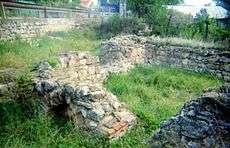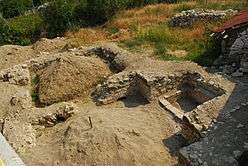Pietroasele
| Pietroasele | |
|---|---|
| Commune | |
 Location of Pietroasele | |
| Coordinates: 45°06′N 26°34′E / 45.100°N 26.567°ECoordinates: 45°06′N 26°34′E / 45.100°N 26.567°E | |
| Country | Romania |
| County | Buzău County |
| Component villages | Câlţeşti, Clondiru de Sus, Dara, Pietroasa Mică, Pietroasele, Şarânga |
| Government | |
| • Mayor | Cornel Enache (since 2004) (PD) |
| Population (2002) | |
| • Total | 3,750 |
| Website | www.pietroasele.ro |
Pietroasele is a commune in Buzău County, Romania, known for its vineyards. The name means "the rockies". The commune is composed of six villages: Câlţeşti, Clondiru de Sus, Dara, Pietroasa Mică, Pietroasele and Şarânga. It became famous with the discovery in 1837 of the Treasury Pietroasa composed of several pieces of gold and precious stones. The Romanian historian Alexandru Odobescu wrote a book on the archaeological discovery.
The village is a popular center with several archaeological sites such as the Dacian fortress at Dari Gruiu. The six locations that make up the commune were built after the sixteenth century, on the lands of freeholders and lords of the neighboring village of Bădeni, and were later divided into three municipalities: Pietroasa de Jos, Pietroasa de Sus and Şarânga, which were merged in 1968.
Although it was initially a center for stone extraction, today viticulture is the main economic sector of the village, known for Romanian wine. The Viticulture Research Center found here is managed by the University of Agricultural Sciences in Bucharest.
History
A Dacian fortress is located at 1,5 km north of Pietroasa Mică village. [1]

Ruins of a third-fourth century AD Roman castra and thermae were discovered in the area in the 1980s. The Roman fort of Pietroasa de Jos, well beyond the Danubian Limes and near present-day Moldavia, would seem to have been occupied in the fourth century A.D. It was connected to bridge-head forts (Sucidava,[2] castra of Tirighina-Bărboși, and the unlocated Constantiniana Daphne) along the left bank of the Danube river.
Near this Roman fort, built by Constantine I when he created the Constantine Wall of the Limes Moesiae probably around 330 AD, researchers have found even a small thermae building in the 1980s.[3] The Roman fortification (124 m x 158 m) was built in an area where was present the Culture of Pietroasa.[4] The wall was 2.7 meters thick. Some stamped bricks of XI Claudia Pia Fidelis from Durostorum, specific to Traian ages, were discovered. Bricks stamps with LEG XI CL ANT and LEG XI CPF.[5] Nowadays there is a small museum on the former site of the castrum.
The nearly 4000 people living in Pietroasele live mainly of agriculture and farming, but a few are employed in tourism related to the Roman discoveries and museum.
The Petroassa treasure

The Pietroasele treasure, an Ostrogothic hoard uncovered in 1837 by local villagers, is on display at the National Museum of Romanian History, in Bucharest. The original gold hoard, discovered within a large ring barrow known as "Istriţa hill" near Pietroasele, is a late fourth-century Gothic treasure that included some twenty-two objects of gold, among the most famous examples of the polychrome style of Migration Period art. The total weight of the find was approximately 20 kilograms (44 lb).
Of the twenty-two pieces, only twelve have survived, conserved at the National Museum of Romanian History, in Bucharest: a large eagle-headed fibula and three smaller ones encrusted with semi-precious stones; a patera, or round sacrificial dish, modelled with Orphic figures [6] surrounding a seated three-dimensional goddess in the center; a twelve-sided cup, a ring with a Gothic runic inscription, a large tray, two other necklaces and a pitcher.
Two of the targets are classified as monuments of architecture, both in the village of Pietroasele: a stone fountain dating from 1892 and a viticulture research station built in 1893. Three objects are considered tombstones or memorials: Crucea Frumoasă (Beautiful Cross), dating from the 19th century, Stan Avram and Ion Lemnaru (1841) from Pietroasa Minor.
See also
References
- ↑ "National Archaeological Record (RAN)". Retrieved 10 October 2012.
- ↑ Sucidava photos
- ↑ Archeological research about Romans in Romania during the 3rd and 4th centuries AD (in Romanian)
- ↑ Castrul roman de la Pietroasa de Jos (in Romanian)
- ↑ Alexandru Madgearu Istoria Militara a Daciei Post Romane 275-376 page 126
- ↑ Campbell, Joseph. The Masks of God: Creative Mythology. 1968.
External links
 Media related to Pietroasele, Buzău at Wikimedia Commons
Media related to Pietroasele, Buzău at Wikimedia Commons- Illustrations
- Coins depicting the treasure
